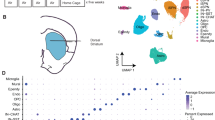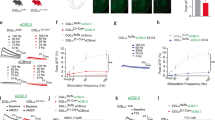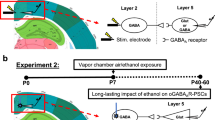Abstract
The dorsolateral striatum mediates habit formation, which is expedited by exposure to alcohol. Across species, alcohol exposure disinhibits the DLS by dampening GABAergic transmission onto this structure’s principal medium spiny projection neurons (MSNs), providing a potential mechanistic basis for habitual alcohol drinking. However, the molecular and circuit components underlying this disinhibition remain unknown. To examine this, we used a combination of whole-cell patch-clamp recordings and optogenetics to demonstrate that ethanol potently depresses both MSN- and fast-spiking interneuron (FSI)-MSN GABAergic synaptic transmission in the DLS. Concentrating on the powerfully inhibitory FSI-MSN synapse, we further show that acute exposure of ethanol (50 mM) to striatal slices activates delta opioid receptors that reside on FSI axon terminals and negatively couple to adenylyl cyclase to induce a long-term depression of GABA release onto both direct and indirect pathway MSNs. These findings elucidate a mechanism through which ethanol may globally disinhibit the DLS.
Similar content being viewed by others

Log in or create a free account to read this content
Gain free access to this article, as well as selected content from this journal and more on nature.com
or
References
Adermark L, Lovinger DM (2009). Frequency-dependent inversion of net striatal output by endocannabinoid-dependent plasticity at different synaptic inputs. J Neurosci 29: 1375–1380.
Al-Hasani R, Bruchas MR (2011). Molecular mechanisms of opioid receptor-dependent signaling and behavior. Anesthesiology 115: 1363–1381.
Atwood BK, Kupferschmidt DA, Lovinger DM (2014a). Opioids induce dissociable forms of long-term depression of excitatory inputs to the dorsal striatum. Nature Neurosci 17: 540–548.
Atwood BK, Lovinger DM, Mathur BN (2014b). Presynaptic long-term depression mediated by Gi/o-coupled receptors. Trends in Neurosci 37: 663–673.
Balleine BW, Liljeholm M, Ostlund SB (2009). The integrative function of the basal ganglia in instrumental conditioning. Behav Brain Res 199: 43–52.
Bevan MD, Booth PA, Eaton SA, Bolam JP (1998). Selective innervation of neostriatal interneurons by a subclass of neuron in the globus pallidus of the rat. J Neurosci 18: 9438–9452.
Blomeley CP, Cains S, Smith R, Bracci E (2011). Ethanol affects striatal interneurons directly and projection neurons through a reduction in cholinergic tone. Neuropsychopharmacology 36: 1033–1046.
Brick J, Erickson CK (2009). Intoxication is not always visible: an unrecognized prevention challenge. Alcohol Clin Exp Res 9: 1489–1507.
Choi S, Lovinger DM (1997). Decreased frequency but not amplitude of quantal synaptic responses associated with expression of corticostriatal long-term depression. J Neurosci 17: 8613–8620.
Clarke RB, Adermark L (2010). Acute ethanol treatment prevents endocannabinoid-mediated long-lasting disinhibition of striatal output. Neuropharmacology 58: 799–805.
Corbit LH, Nie H, Janak PH (2012). Habitual alcohol seeking: time course and the contribution of subregions of the dorsal striatum. Biol Psychiatry 72: 389–395.
Cuzon Carlson VC, Seabold GK, Helms CM, Garg N, Odagiri M, Rau AR et al (2011). Synaptic and morphological neuroadaptations in the putamen associated with long-term, relapsing alcohol drinking in primates. Neuropsychopharmacology 36: 2513–2528.
Della Rocca GJ, Mukhin YV, Garnovskaya MN, Daaka Y, Clark GJ, Luttrell LM et al (1999). Serotonin 5-HT1A receptor-mediated Erk activation requires calcium/calmodulin-dependent receptor endocytosis. Biol Chem 274: 4749–4753.
Dickinson A, Wood N, Smith JW (2002). Alcohol seeking by rats: action or habit? Q J Exp Psychol B 55: 331–348.
Drews E, Zimmer A (2010). Modulation of alcohol and nicotine responses through the endogenous opioid system. Prog Neurobiol 90: 1–15.
Gerdeman GL, Ronesi J, Lovinger DM (2002). Postsynaptic endocannabinoid release is critical to long-term depression in the striatum. Nat Neurosci 5: 446–451.
Gerfen CR, Engber TM, Mahan LC, Susel Z, Chase TN, Monsma FJ Jr et al (1990). D1 and D2 dopamine receptor-regulated gene expression of striatonigral and striatopallidal neurons. Science 250: 1429–1432.
Iremonger KJ, Bains JS (2009). Retrograde opioid signaling regulates glutamatergic transmission in the hypothalamus. J Neurosci 29: 7349–7358.
Koos T, Tepper JM, Wilson CJ (2004). Comparison of IPSCs evoked by spiny and fast-spiking neurons in the neostriatum. J Neurosci 24: 7916–7922.
Luk KC, Sadikot AF (2001). GABA promotes survival but not proliferation of parvalbumin-immunoreactive interneurons in rodent neostriatum: an in vivo study with stereology. Neuroscience 104: 93–103.
Mallet N, Micklem BR, Henny P, Brown MT, Williams C, Bolam JP et al (2012). Dichotomous organization of the external globus pallidus. Neuron 74: 1075–1086.
Mastro KJ, Bouchard RS, Holt HA, Gittis AH (2014). Transgenic mouse lines subdivide external segment of the globus pallidus (GPe) neurons and reveal distinct GPe output pathways. J Neurosci 34: 2087–2099.
Mathur BN, Capik NA, Alvarez VA, Lovinger DM (2011). Serotonin induces long-term depression at corticostriatal synapses. J Neurosci 31: 7402–7411.
Mathur BN, Tanahira C, Tamamaki N, Lovinger DM (2013). Voltage drives diverse endocannabinoid signals to mediate striatal microcircuit-specific plasticity. Nat Neurosci 16: 1275–1283.
Nielsen CK, Simms JA, Li R, Mill D, Yi H, Feduccia AA et al (2012). Delta-opioid receptor function in the dorsal striatum plays a role in high levels of ethanol consumption in rats. J Neurosci 32: 4540–4552.
Scherrer G, Tryoen-Tóth P, Filliol D, Matifas A, Laustriat D, Cao YQ et al (2006). Knockin mice expressing fluorescent delta-opioid receptors uncover G protein-coupled receptor dynamics in vivo. Pro Natl Acad Sci USA 103: 9691–9696.
Schlösser B, Klausa G, Prime G, Ten Bruggencate G (1999). Postnatal development of calretinin- and parvalbumin-positive interneurons in the rat neostriatum: an immunohistochemical study. J Comp Neurol 405: 185–198.
Surmeier DJ, Song WJ, Yan Z (1996). Coordinated expression of dopamine receptors in neostriatal medium spiny neurons. J Neurosci 16: 6579–6591.
Tepper JM, Koós T, Wilson CJ (2004). GABAergic microcircuits in the neostriatum. Trends Neurosci 27: 662–669.
Volpicelli JR, Alterman AI, Hayashida M, O'Brien CP. (1992). Naltrexone in the treatment of alcohol dependence. Arch Gen Psychiatry 49: 876–880.
Wamsteeker Cusulin JI, Füzesi T, Inoue W, Bains JS (2013). Glucocorticoid feedback uncovers retrograde opioid signaling at hypothalamic synapses. Nat Neurosci 16: 596–604.
Wassum KM, Cely IC, Maidment NT, Balleine BW (2009). Disruption of endogenous opioid activity during instrumental learning enhances habit acquisition. Neuroscience 163: 770–780.
Wilcox MV, Cuzon Carlson VC, Sherazee N, Sprow GM, Bock R, Thiele TE et al (2014). Repeated binge-like ethanol drinking alters ethanol drinking patterns and depresses striatal GABAergic transmission. Neuropsychopharmacology 39: 579–594.
Yin HH, Knowlton BJ, Balleine BW (2004). Lesions of dorsolateral striatum preserve outcome expectancy but disrupt habit formation in instrumental learning. Eur J Neurosci 19: 181–189.
Yin HH, Ostlund SB, Knowlton BJ, Balleine BW (2005). The role of the dorsomedial striatum in instrumental conditioning. Eur J Neurosci 22: 513–523.
Author information
Authors and Affiliations
Corresponding author
Rights and permissions
About this article
Cite this article
Patton, M., Roberts, B., Lovinger, D. et al. Ethanol Disinhibits Dorsolateral Striatal Medium Spiny Neurons Through Activation of A Presynaptic Delta Opioid Receptor. Neuropsychopharmacol 41, 1831–1840 (2016). https://doi.org/10.1038/npp.2015.353
Received:
Revised:
Accepted:
Published:
Issue date:
DOI: https://doi.org/10.1038/npp.2015.353
This article is cited by
-
Compulsive alcohol consumption is regulated by dorsal striatum fast-spiking interneurons
Neuropsychopharmacology (2021)
-
TrkB-dependent disinhibition of the nucleus accumbens is enhanced by ethanol
Neuropsychopharmacology (2019)
-
Ensemble encoding of action speed by striatal fast-spiking interneurons
Brain Structure and Function (2019)
-
Acute drug effects on habitual and non-habitual responding in crossed high alcohol preferring mice
Psychopharmacology (2018)
-
Ethanol-Sensitive Pacemaker Neurons in the Mouse External Globus Pallidus
Neuropsychopharmacology (2017)


